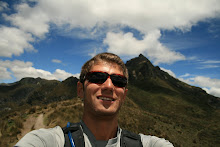Mindo is a district in the canton of Los Bancos 84 km west of Quito, with a rapidly growing tourist industry based on Ecotourism in the Mindo-Nambillo Protected Forest. Small commercial enterprises exhibiting butterflies, hummingbirds, orchids and bromeliads abound.
The Mindo area ranges from approximately 1400 to 4780m above sea level, and its most popular attractions are typical of the cloud forest flora and fauna. Temperatures range from about 15ºC – 24ºC (60ºF – 75ºF), and rain storms are common throughout the year, although the climate is driest from May – September.
July - October are the busiest months for overseas tourists, but weekends and national holidays throughout the year find many Quiteños in Mindo.
Cloud forests like Mindo have high humidity, cool temperatures and an abundance of wildlife and plants, particularly epiphytes, varieties that grow on other plants.
While Mindo Ecuador cloud forest is a heaven for bird watchers, it also appeals to photographers and explorers for its outstanding panoramic views. The Valley of Mindo is considered to be one of South America's best bird-watching sites.
BirdLife International named Mindo as the first IBA or Important Bird Area in the Americas in 1997, for its exceptional flora, fauna and botanical abundance, unique in species, considered vital for the development of ecological tourism.
And the area has recently achieved the highest single day bird count during the world-wide Audubon Christmas Count.
So for a birder, this region of Ecuador has to be a "prime destination". And of course Don't forget to pack your binoculars!!
Also, every 200 meters or so drop in altitude means a change in the species of birds that live here in Mindo.
Consider that Ecuador which only covers 0.02% of the earth's land surface, holds about 10% of all bird species found on the planet and it is not an exaggeration to state that an inordinately high number of Ecuador's 1,600 species of birds are found in the Cloud Forests!
Just to mention a few, some of which are endemic (unique) to this cloud forest:
Tanager-Finch
Andean Cock-of-the-Rock
Plate-billed Mountain-Toucan
35 species of Tanagers of all colors
manakins
Cotingas and more...
Watch for other specialties such as Black-and-Chestnut Eagle, over 20 species of hummingbirds, Golden-headed and Crested Quetzals, Toucan Barbet and Powerful Woodpeckers.
Over 170 species of orchids have been identified within the reserve of Mindo Ecuador, which lies in a region with some of the highest rates of plant endemism in the world.
Orchids, bromeliads, heliconias, ferns, vines, mosses and lichens grow in abundance here.
Mindo is also a perfect area for adventure sports like: Horseback riding, mountain biking tubing and also rafting in the rushing Mindo river.






